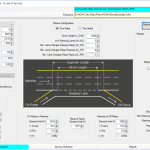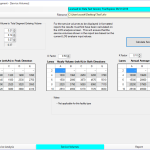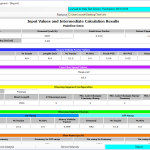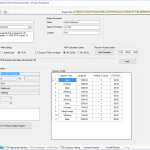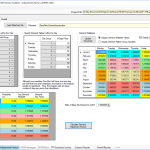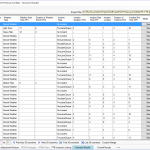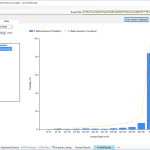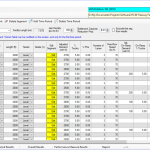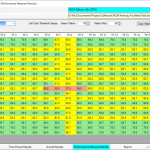 The 6th edition of the Highway Capacity Manual (HCM) (developed and maintained by the Transportation Research Board) has recently been released at http://www.trb.org/publications/hcm6e.aspx. Dr. Scott Washburn is distributing, at no cost, new software tools that address the uninterrupted-flow analysis methodologies of the HCM. HCM-CALC, developed by Dr. Washburn, includes modules to perform the analysis methodologies of all the uninterrupted flow facilities of the HCM 5th and 6th editions:
The 6th edition of the Highway Capacity Manual (HCM) (developed and maintained by the Transportation Research Board) has recently been released at http://www.trb.org/publications/hcm6e.aspx. Dr. Scott Washburn is distributing, at no cost, new software tools that address the uninterrupted-flow analysis methodologies of the HCM. HCM-CALC, developed by Dr. Washburn, includes modules to perform the analysis methodologies of all the uninterrupted flow facilities of the HCM 5th and 6th editions:
- Freeway Facility
- Basic Freeway Segment
- Freeway Merge/Diverge Segment
- Freeway Weaving Segment
- Multilane Highway Segment
- Two-Lane Highway Segment
All of the individual segment modules have the following capabilities/features:
Other Features:
- Input files for HCM example problems are available
- For adopters of the textbook Principles of Highway Engineering and Traffic Analysis, all (40+) HCM-CALC input files, corresponding to the Chapter 6 end-of-chapter problems, are available
- Input files are in XML format. This makes it easy to use custom processing tools to create/edit files outside of software user interface.
- Performs calculations for the 5th and 6th editions of the HCM
In a project funded by the Federal Highway Administration (FHWA), Dr. Scott Washburn led the development of a software tool that implements the freeway Travel Time Reliability and Active Transportation & Demand Management (TTR/ATDM) analysis methodologies of the HCM. The TTR/ATDM module utilizes the Freeway Facility calculation engine of the HCM-CALC software tool. The TTR/ATDM Utility facilitates the specification of hundreds, or even thousands, of freeway facility scenarios with varying input conditions and executes the calculation of all these scenarios in just seconds.
TTR/ATDM Features
- Performs TTR calculations for HCM, SHRP2-L08, and Unrestricted methodologies.
- Individual scenarios can be exported to Freeway Facility module, which provides for quick verification of internal consistency of calculations, as well as access to additional results and outputs
- Data files are in XML format. This makes it easy to use custom processing tools to create/edit files outside of software user interface.
- File structure is disaggregate, making it easy to mix and match various input files and avoiding duplication of input effort for different projects.
- Outputs can be saved to CSV file or copied to the clipboard.
- Flexible chart displays for multiple performance measures.
Sample Screenshots
For additional software information, including screen shots and user guides, see http://swashware.com.
The software has undergone extensive testing, with real-world applications by practitioners, and the software calculations have been verified against all of the HCM example problems, as well as over 40 problems from the textbook “Principles of Highway Engineering and Traffic Analysis.”
The software architecture has enabled a tight integration between the TTR/ATDM Utility, the Freeway Facility module, and the individual segment modules. This provides an intuitive and efficient analysis experience. In the near future, the freeway facility module will also be able to export its network files to the SwashSim microscopic traffic simulation program.

How to obtain the software? Two options:
Microsoft Store
1) If you are running the latest version (1607) of Windows 10 on your computer, you can download the software from https://www.microsoft.com/en-us/store/p/hcm-calc/9nblggh538w4
What are the benefits of distributing the program through the Microsoft Store?
- Simple install and uninstall process
- Simple mechanism for providing user feedback
- Automatic notification of updates
- Apps distributed through Store are vetted by Microsoft for compliance with Windows operational and security guidelines
2) If you are running an older version of Windows, contact Dr. Washburn, swash@ce.ufl.edu, to obtain the software.
About Dr. Scott Washburn:
Dr. Washburn is a professor in the Department of Civil and Coastal Engineering at the University of Florida. Dr. Washburn’s areas of transportation engineering expertise include traffic flow theory and traffic operations analysis. Dr. Washburn also has an extensive background in computer science/computer programming. Much of Dr. Washburn’s research efforts are aimed at improving and enhancing traffic analysis methods, as well as developing complimentary software tools. Dr. Washburn has been very actively involved with the Highway Capacity and Quality of Service Committee (HCQSC) for the Transportation Research Board since 2001 and was a formal member of the committee from 2006-2016. During this time, Dr. Washburn also served as chair of the Freeways/Multilane Highways subcommittee (2006-2011) and as chair of the User Liaison subcommittee (2011-2016). Dr. Washburn is also the principal investigator for the in-progress NCHRP 17-65 project that is developing a new two-lane highway analysis methodology for the HCM. More information about Dr. Washburn can be found at swash.essie.ufl.edu.

